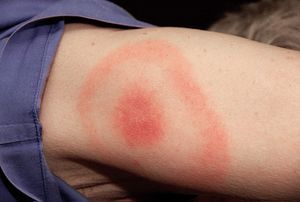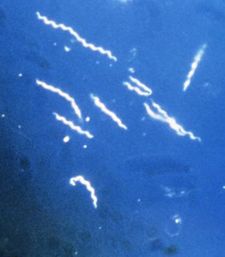Chronic Lyme disease
Chronic Lyme disease is a generally rejected diagnosis that encompasses "a broad array of illnesses or symptom complexes for which there is no reproducible or convincing scientific evidence of any relationship to Borrelia burgdorferi infection."[1] Despite numerous studies, there is no clinical evidence that "chronic" Lyme disease is caused by a persistent infection.[2] It is distinct from post-treatment Lyme disease syndrome, a set of lingering symptoms which may persist after successful treatment of infection with Lyme spirochetes. The symptoms of "chronic Lyme" are generic and non-specific "symptoms of life".[3][4][5]
Lyme disease is caused by the bacterium borrelia burgdorferi and transmitted through the bite of a deer tick or black legged tick.[6] A bulls-eye rash can appear at the site of a deer tick bite but can be in different forms[7] while some people never recall having a rash.
Symptoms[edit | edit source]
The signs and symptoms of lyme disease vary and usually appear in stages.[8]
Early Signs and Symptoms
- Bull's eye rash (Rash can be in other forms and 30% of the time no rash is present.)[9][10]
- Flu-like symptoms
Later Signs and Symptoms
- Erythema migrans[11]
- Joint pain
- Neurological problems
Signs and symptoms may also include
- Nausea and vomiting
- Diffuse rashes (rather than a single bull's-eye rash commonly associated with Lyme disease)[9] See: Images
Less Common Signs and Symptoms
- Heart problems, such as irregular heartbeat.
- Eye inflammation
- Liver inflammation (hepatitis).
- Severe fatigue[8]
Treatment and management[edit | edit source]
- 2018, Lyme Disease Treatment & Management - Approach Considerations[12]
- 2018, Lyme Disease Treatment & Management - Treatment of Early Lyme Disease[13]
- 2018, Lyme Disease Treatment & Management - Post-Treatment Lyme Disease Syndrome[14]
Notable research[edit | edit source]
- 2013, Quirky Lyme disease bacteria: Unlike most organisms, they don't need iron, but crave manganese[15]
Multiple Pathogens[edit | edit source]
Pathobiome Paradigm[edit | edit source]
- 2015, Some future research will focus on a spectrum of pathogens instead of a "one pathogen-one disease" vision.[19]
United States Congressional Report[edit | edit source]
Blood and other laboratory tests[edit | edit source]
United States[edit | edit source]
- Two-step Laboratory Testing Process[21]
- Types of Lyme Disease Tests[22]
- Laboratory tests that are not recommended[23]
United Kingdom[edit | edit source]
- BBC1 Lyme Disease Discussion - Some patients have waited up to 30 years for a correct diagnosis. National Health Service (NHS) services have only correctly identified the disease in a quarter of the patients. The blood tests are unreliable and often come back negative. The development of an accurate blood test is in need of research funding.[24]
False positives[edit | edit source]
Several herpesviruses including varicella zoster virus[26][27], cytomegalovirus, Epstein-Barr virus,[28] and HSV-2[29] may cause false positives on Lyme Disease tests.
News media on unapproved tests[edit | edit source]
Co-infections[edit | edit source]
Herpesviruses[edit | edit source]
Lyme may cause reactivation of latent herpesviruses. At the same time, several herpesviruses including varicella zoster virus,[26][27] cytomegalovirus, epstein-barr virus,[28] and HSV-2[29] may cause false positives on lyme disease tests.
Pathobiome paradigm[edit | edit source]
Some future research will focus on a spectrum of pathogens instead of a "one pathogen-one disease" vision.[34]
Lyme Disease vs Chronic Fatigue Syndrome[edit | edit source]
- 2009, "The Department of Health and Social Care (UK) remains concerned about the growing number of patients, particularly those suffering from chronic conditions such as myalgic encephalopathy (ME) or chronic fatigue syndrome, who receive a false diagnosis of Lyme disease from private laboratories offering unvalidated tests that lack the sensitivity and specificity to detect B. burgdorferi. A report of the Department’s investigation into the use of such tests in the diagnosis of Lyme disease is available at Report on Lyme Disease: Unorthodox and Unvalidated Laboratory Tests in the Diagnosis of Lyme Borreliosis and in Relation to Medically Unexplained Symptoms. Misinformation about Lyme disease is readily available to patients via the internet and can lead them to seek inappropriate diagnosis and treatment." [25]
- 2011, Lyme Disease and Chronic Fatigue Syndrome are different diseases. Research is published on cerebrospinal fluid, and distinct differences were found.[35]
- 2016, Post Lyme Disease and Chronic Fatigue Syndrome (ME/CFS) – Are They The Same?[36]
- There are many historical outbreaks of Myalgic Encephalomyelitis and Chronic Fatigue Syndrome that do not correlate with a tick-borne pathogen.
See also[edit | edit source]
Learn more[edit | edit source]
References[edit | edit source]
- ↑ Feder, Henry M.; Johnson, Barbara J.B.; O'Connell, Susan; Shapiro, Eugene D.; Steere, Allen C.; Wormser, Gary P. (October 4, 2007). "A Critical Appraisal of "Chronic Lyme Disease"". New England Journal of Medicine. 357 (14): 1422–1430. doi:10.1056/nejmra072023. ISSN 0028-4793.
- ↑ Baker, Phillip J. (2010). "Chronic Lyme disease: in defense of the scientific enterprise". The FASEB Journal. 24 (11): 4175–4177. doi:10.1096/fj.10-167247. ISSN 0892-6638.
- ↑ 3.0 3.1 "Post-Treatment Lyme Disease Syndrome | Lyme Disease | CDC". www.cdc.gov. December 1, 2017. Retrieved September 19, 2018.
- ↑ Hall, Harriet (September 3, 2013). "Does Everybody Have Chronic Lyme Disease? Does Anyone?". sciencebasedmedicine.org. Retrieved September 6, 2018. Cite has empty unknown parameter:
|dead-url=(help) - ↑ "Chronic Lyme disease". Wikipedia. July 25, 2018.
- ↑ "Lyme Disease | Lyme Disease | CDC". www.cdc.gov. January 19, 2018. Retrieved September 3, 2018.
- ↑ "Does Everyone Get the Telltale Bullseye Rash? | Bay Area Lyme Foundation". Bay Area Lyme Foundation. September 12, 2014. Retrieved September 3, 2018.
- ↑ 8.0 8.1 "Lyme disease - Symptoms and causes". Mayo Clinic. Retrieved September 3, 2018.
- ↑ 9.0 9.1 "Does Everyone Get the Telltale Bullseye Rash? | Bay Area Lyme Foundation". Bay Area Lyme Foundation. September 12, 2014. Retrieved September 3, 2018.
- ↑ "Lyme Disease: Symptoms, Causes, Diagnosis, Treatment, Prevention". WebMD. Retrieved September 6, 2018.
- ↑ "Lyme Disease (Erythema-Migrans) Picture Image on MedicineNet.com". MedicineNet. Retrieved September 3, 2018.
- ↑ Meyerhoff, John O. (May 17, 2018). Diamond, Herbert S. (ed.). "Lyme Disease Treatment & Management: Approach Considerations, Treatment of Early Lyme Disease, Lyme Arthritis". Medscape. Approach Considerations.
- ↑ Meyerhoff, John O. (May 17, 2018). Diamond, Herbert S. (ed.). "Lyme Disease Treatment & Management: Approach Considerations, Treatment of Early Lyme Disease, Lyme Arthritis". Medscape. Treatment of Early Lyme Disease.
- ↑ Meyerhoff, John O. (May 17, 2018). Meyerhoff, Herbert S. (ed.). "Lyme Disease Treatment & Management: Approach Considerations, Treatment of Early Lyme Disease, Lyme Arthritis". Medscape. Post-Treatment Lyme Disease Syndrome.
- ↑ "Quirky Lyme disease bacteria: Unlike most organisms, they don't need iron, but crave manganese". ScienceDaily. Woods Hole Oceanographic Institution. March 21, 2013. Retrieved September 3, 2018. Cite has empty unknown parameter:
|dead-url=(help) - ↑ "Ticks that transmit Lyme disease reported in nearly half of all US counties". ScienceDaily. Entomological Society of America. January 18, 2016. Retrieved September 3, 2018. Cite has empty unknown parameter:
|dead-url=(help) - ↑ Kurtzman, Laura (February 12, 2016). "Gene Signature Could Lead To A New Way Of Diagnosing Lyme". UC San Francisco. Retrieved September 3, 2018. Cite has empty unknown parameter:
|dead-url=(help) - ↑ "Researchers identify new Borrelia species that causes Lyme disease: Until now, Borrelia burgdorferi was only species believed to cause Lyme disease in North America". ScienceDaily. February 8, 2016. Retrieved August 13, 2018. Cite has empty unknown parameter:
|dead-url=(help) - ↑ Vayssier-Taussat, M; Kazimirova, M; Hubalek, Z; Hornok, S; Farkas, R; Cosson, JF; Bonnet, S; Vourch, G; Gasqui, P; Mihalca, AD; Plantard, O; Silaghi, C; Cutler, S; Rizzlo, A (November 19, 2015), "Emerging horizons for tick-borne pathogens: from the 'one pathogen-one disease' vision to the pathobiome paradigm", Future Microbiol, 10 (12): 2033-43, doi:10.2217/fmb.15.114, PMID 26610021
- ↑ Aucott, John N; Honey, Kristen T; Adams, Wendy; Beard, Charles Benjamin; Cooper, Captain Scott; Dixon, Dennis; Horowitz, Richard; Jones, Captain Estella; Nigrovic, Lisa E (2018). "Tick-Borne Disease Working Group - 2018 Report to Congress" (PDF). drive.google.com. Allen Richards; Robert Sabatino; Vanila Singh; Patricia Smith; Robert Smith. Retrieved November 26, 2018. Cite has empty unknown parameter:
|dead-url=(help) - ↑ "Two-step Laboratory Testing Process| Lyme Disease | CDC". www.cdc.gov. Retrieved September 3, 2018.
- ↑ "Types of Lyme Disease Tests". lymediseaseguide.org. May 27, 2011. Retrieved September 3, 2018. Cite has empty unknown parameter:
|dead-url=(help) - ↑ "Laboratory tests that are not recommended| Lyme Disease | CDC". www.cdc.gov. Retrieved September 3, 2018.
- ↑ Loukas, Demetrios (February 27, 2016). "BBC1 Lyme Disease 27.02.2016". YouTube. Katherine Allman. Cite has empty unknown parameter:
|dead-url=(help) - ↑ 25.0 25.1 Donaldson, Liam (2009). "Testing for Lyme Disease" (PDF). webarchive.nationalarchives.gov.uk (PDF). p. 4. Cite has empty unknown parameter:
|dead-url=(help) - ↑ 26.0 26.1 Feder, HM Jr; Gerber, MA; Luger, SW; Ryan, RW (December 1991), "False-positive serologic tests for Lyme disease after varicella infection", N Engl J Med, 325 (26): 1886-7, PMID 1961232
- ↑ 27.0 27.1 Woelfle, J; Wilske, B; Haverkamp, F; Bialek, R (November 1998), "False-positive serological tests for Lyme disease in facial palsy and varicella zoster meningo-encephalitis", Eur J Pediatr, 157 (1): 953-4, PMID 9835449
- ↑ 28.0 28.1 Goossens, HA; Nohlmans, MK; van den Bogaard, AE (May 1999), "Epstein-Barr virus and cytomegalovirus infections cause false-positive results in IgM two-test protocol for early Lyme borreliosis", Infection, 27 (3): 231, PMID 10378140
- ↑ 29.0 29.1 Strasfeld, L; Romanzi, L; Seder, RH; Berardi, VP (2005), "False-Positive Serological Test Results for Lyme Disease in a Patient with Acute Herpes Simplex Virus Type 2", Clin Infect Dis, 41 (12): 1826-1827, doi:10.1086/498319, PMID 16288417
- ↑ Santora, Dan Hurley and Marc. "Unproved Lyme Disease Tests Prompt Warnings". Retrieved September 3, 2018.
- ↑ Daley, Beth (October 21, 2013). "Many tests to diagnose Lyme, but no proof they do - The Boston Globe". BostonGlobe.com. Retrieved September 3, 2018. Cite has empty unknown parameter:
|dead-url=(help) - ↑ Lyme Culture Test Causes Uproar. "Medscape Log In" (Login Needed). www.medscape.com. Retrieved September 3, 2018. Cite has empty unknown parameter:
|dead-url=(help) - ↑ Daley, Beth (June 17, 2014). "Federal Loopholes Compromise Lyme Disease Testing". WGBH 89.7. Retrieved September 3, 2018. Cite has empty unknown parameter:
|dead-url=(help) - ↑ Vayssier-Taussat, M; Kazimirova, M; Hubalek, Z; Hornok, S; Farkas, R; Cosson, JF; Bonnet, S; Vourch, G; Gasqui, P; Mihalca, AD; Plantard, O; Silaghi, C; Cutler, S; Rizzlo, A (November 19, 2015), "Emerging horizons for tick-borne pathogens: from the 'one pathogen-one disease' vision to the pathobiome paradigm", Future Microbiol, 10 (12): 2033-43, doi:10.2217/fmb.15.114, PMID 26610021
- ↑ Schutzer, SE; Angel, TE; Liu, T; Schepmoes, AA; Clauss, TR; Adkins, JN; Camp, DG; Holland, BK; Bergquist, J; Coyle, PK; Smith, RD; Fallon, BA; Natelson, BH (February 23, 2011), "Distinct Cerebrospinal Fluid Proteomes Differentiate Post-Treatment Lyme Disease from Chronic Fatigue Syndrome", PLoS One, 6 (2): e17287, doi:10.1371/journal.pone.0017287, PMID 21383843
- ↑ Johnson, Cort (August 6, 2016). "Post Lyme Disease and Chronic Fatigue Syndrome (ME/CFS) - Are They The Same? - Simmaron Research". Simmaron Research. Retrieved September 3, 2018. Cite has empty unknown parameter:
|dead-url=(help) - ↑ "Deer Tick | National Geographic". April 11, 2010. Retrieved September 3, 2018.
- ↑ "Lyme Disease". Columbia-lyme.org. Retrieved August 13, 2018. Cite has empty unknown parameter:
|dead-url=(help) - ↑ "Lyme Disease". blausen.com. Blausen. Cite has empty unknown parameter:
|dead-url=(help) - ↑ Paules, Catharine I.; Marston, Hilary D.; Bloom, Marshall E.; Fauci, Anthony S. (July 25, 2018). "Tickborne Diseases — Confronting a Growing Threat | NEJM". New England Journal of Medicine. doi:10.1056/nejmp1807870#.w4x74fva80g.twitter.



